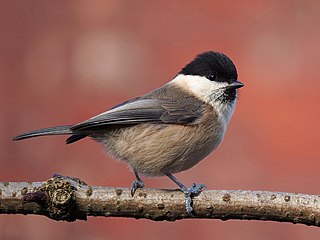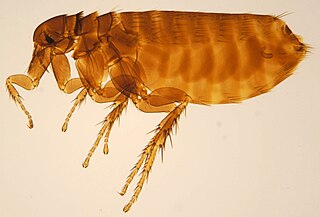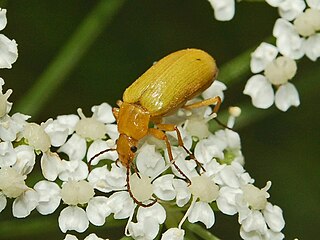
The European robin, known simply as the robin or robin redbreast in Great Britain, is a small insectivorous passerine bird that belongs to the chat subfamily of the Old World flycatcher family. About 12.5–14.0 cm (5.0–5.5 inches) in length, the male and female are similar in colouration, with an orange breast and face lined with grey, brown upper-parts and a whitish belly. It is found across Europe, east to Western Siberia and south to North Africa; it is sedentary in most of its range except the far north.

The stoat or short-tailed weasel, also known as the Eurasian ermine, Beringian ermine, or simply just ermine, is a mustelid native to Eurasia and the northern portions of North America. Because of its wide circumpolar distribution, it is listed as Least Concern on the IUCN Red List.

The willow tit is a passerine bird in the tit family, Paridae. It is a widespread and common resident breeder throughout temperate and subarctic Europe and across the Palearctic. The plumage is grey-brown and off-white with a black cap and bib. It is more of a conifer specialist than the closely related marsh tit, which explains it breeding much further north. It is resident, and most birds do not migrate.

The common moorhen, also known as the waterhen or swamp chicken, is a bird species in the rail family (Rallidae). It is distributed across many parts of the Old World.

The common gallinule is a bird in the family Rallidae. It was split from the common moorhen by the American Ornithologists' Union in July 2011. It lives around well-vegetated marshes, ponds, canals, and other wetlands in the Americas. The species is not found in the polar regions or many tropical rainforests. Elsewhere, the common gallinule is likely the most commonly seen rail species in much of North America, except for the American coot in some regions.

The Eurasian woodcock is a medium-small wading bird found in temperate and subarctic Eurasia. It has cryptic camouflage to suit its woodland habitat, with reddish-brown upperparts and buff-coloured underparts. Its eyes are set far back on its head to give it 360-degree vision and it probes in the ground for food with its long, sensitive bill, making it vulnerable to cold weather when the ground remains frozen.

The Eurasian treecreeper or common treecreeper is a small passerine bird also known in the British Isles, where it is the only living member of its genus, simply as treecreeper. It is similar to other treecreepers, and has a curved bill, patterned brown upperparts, whitish underparts, and long stiff tail feathers which help it creep up tree trunks. It can be most easily distinguished from the similar short-toed treecreeper, which shares much of its European range, by its different song.

The water pipit is a small passerine bird which breeds in the mountains of Southern Europe and the Palearctic eastwards to China. It is a short-distance migrant; many birds move to lower altitudes or wet open lowlands in winter.

The least weasel, little weasel, common weasel, or simply weasel in the UK and much of the world, is the smallest member of the genus Mustela, family Mustelidae and order Carnivora. It is native to Eurasia, North America and North Africa, and has been introduced to New Zealand, Malta, Crete, the Azores, and São Tomé. It is classified as least concern by the IUCN, due to its wide distribution and large population throughout the Northern Hemisphere.

The moorhen flea is a flea originating from South America. It is now globally widespread. It is a large flea, easily identified because the male has two heavy horn-like spines on one of the genital flaps, and the female has a deep "bite" on the seventh sternite.
Dasypsyllus is a widespread genus of fleas. Some of its members are found in bird nests, including the moorhen flea, D. gallinulae.

Ceratophyllus gallinae, known as the hen flea in Europe or the European chicken flea elsewhere, is an ectoparasite of birds. This flea was first described by the German botanist and entomologist Franz von Paula Schrank in 1803.

Cteniopus sulphureus is a species of comb-clawed beetles belonging to the family Tenebrionidae subfamily Alleculinae.

Alleculinae is a subfamily of comb-clawed beetles belonging to the family Tenebrionidae. These beetles are characterized by an oval body, threadlike antennae, relatively long legs and tarsi quite elongated. Their most striking feature, however, are the combed claws of the hind tarsi, that show fine teeth.
Dasypsyllus aemulus is a species of flea in the family Ceratophyllidae. It was described by Karl Jordan in 1933.
Dasypsyllus comatus is a species of flea in the family Ceratophyllidae. It was described by Karl Jordan in 1933.
Dasypsyllus stejnegeri is a species of flea in the family Ceratophyllidae. It was described by Karl Jordan in 1929.
Dasypsyllus lasius is a species of flea in the family Ceratophyllidae. It was described by Rothschild in 1909.
Dasypsyllus plumosissimus is a species of flea in the family Ceratophyllidae. It was described by Smit in 1976.
Dasypsyllus araucanus is a species of flea in the family Ceratophyllidae. It was described by Karl Jordan and Charles Rothschild in 1920.












